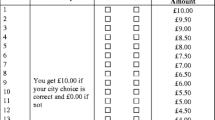Abstract
The “hard-easy effect” is a well-known cognitive bias on self-confidence calibration that refers to a tendency to overestimate the probability of success in hard-perceived tasks, and to underestimate it in easy-perceived tasks. This paper provides a target-based foundation for this effect, and predicts its occurrence in the expected utility framework when utility functions are S-shaped and asymmetrically tailed. First, we introduce a definition of hard-perceived and easy-perceived task based on the mismatch between an uncertain target to meet and a suitably symmetric reference point. Second, switching from a target-based language to a utility-based language, we show how this maps to equivalence between the hard-perceived target/gain seeking and the easy-perceived target/loss aversion. Third, we characterize the agent’s miscalibration in self-confidence. Sufficient conditions for acting according to the “hard-easy effect” and the “reversed hard-easy effect” biases are set out. Finally, we derive sufficient conditions for the “hard-easy effect” and the “reversed hard-easy effect” to hold. As a by-product we identify situations in enterprise risk management where misconfidence in judgments emerges. Recognizing these cognitive biases, and being mindful of to be normatively influenced by them, gives the managers a better framework for decision making.
Access this chapter
Tax calculation will be finalised at checkout
Purchases are for personal use only
Similar content being viewed by others
Notes
- 1.
A sufficient condition for inequality (b) is that the probability density f of T satisfies for some \( \zeta >\mathsf{0} \), \( \mathit{\mathsf{f}}\left(\mathit{\mathsf{m}}-\mathit{\mathsf{x}}\right)+\mathit{\mathsf{f}}\left(\mathit{\mathsf{m}}+\mathit{\mathsf{x}}\right)\ge \mathsf{0} \) for \( \mathsf{0}\le \mathit{\mathsf{x}}\le \zeta \) and \( \mathit{\mathsf{f}}\left(\mathit{\mathsf{m}}-\mathit{\mathsf{x}}\right)+\mathit{\mathsf{f}}\left(\mathit{\mathsf{m}}+\mathit{\mathsf{x}}\right)\le \mathsf{0} \) for \( \zeta <\mathit{\mathsf{x}}<\infty \), see Eq. (2.1) van Zwet (1979). The probability density f of any Pearson distribution of Type I to XII satisfies the above condition; see also Sato (1997).
References
Abadir, K. M. (2005). The mean-median-mode inequality: Counterexamples. Econometric Theory, 21(2), 477–482.
Abdous, B., & Theodorescu, R. (1998). Mean, median, mode IV. Statistica Neerlandica, 52, 356–359.
Berhold, M. H. (1973). The use of distribution functions to represent utility functions. Management Science, 19, 825–829.
Borch, K. (1968). Decision rules depending on the probability of ruin. Oxford Economic Papers, 20(1), 1–10.
Bordley, R., & LiCalzi, M. (2000). Decision analysis using targets instead of utility functions. Decisions in Economics and Finance, 23, 53–74.
Burks, S. V., Carpente, J. P., Goette, L., & Rustichini, A. (2013). Overconfidence and social signalling. Review of Economic Studies, 80(3), 949–983.
Castagnoli, E., & LiCalzi, M. (1996). Expected utility without utility. Theory and Decision, 41(3), 281–301.
Conine, T. E. (2014). Estimating the probability of meeting financial commitments: A behavioral finance perspective based on business simulations. Global Business and Organizational Excellence, 33, 6–13.
Giardini, F., Coricelli, G., Joffily, M., & Sirigu, A. (2008). Overconfidence in predictions as an effect of desirability bias. In M. Abdellaoui & J. D. Hey (Eds.), Advances in decision making under risk and uncertainty (Theory and Decision Library C, Vol. 42, pp. 163–180). Berlin: Springer.
Heath, C., Larrick, R., & Wu, G. (1999). Goals as reference points. Cognitive Psychology, 38, 79–109.
Hoffmann, A. O. I., Henry, S. F., & Kalogeras, N. (2013). Aspirations as reference points: An experimental investigation of risk behavior over time. Theory and Decision, 75, 193–210.
Kahneman, D., Knetsch, J. L., & Thaler, R. H. (1991). Anomalies: The endowment effect, loss aversion, and status quo bias. The Journal of Economic Perspectives, 5, 193–206.
Kahneman, D., & Tversky, A. (1979). Prospect theory: An analysis of decisions under risk. Econometrica, 47(2), 263–291.
Kahneman, D., & Tversky, A. (1992). Advances in prospect theory: Cumulative representation of uncertainty. Journal of Risk and Uncertainty, 5, 297–323.
Kelly, T. (2004). Sunk costs, rationality, and acting for the sake of the past. Nous, 38(1), 60–85.
Lee, J. S., Keil, M., & Wong, K. F. E. (2015). The effect of goal difficulty on escalation of commitment. Journal of Behavioral Decision Making, 28(2), 114–129.
LiCalzi, M. (1999). A language for the construction of preferences under uncertainty. Revista de la Real Academia de Ciencias Exactas, Fìsicas y Naturales, 93, 439–450.
Lichtenstein, S., & Fischhoff, B. (1977). Do those who know more also know more about how much they know? Organizational Behavior and Human Performance, 20(2), 159–183.
Lichtenstein, S., Fischhoff, B., & Phillips, L. D. (1982). Calibration of subjective probabilities: The state of the art up to 1980. In D. Kahneman, P. Slovic, & A. Tversky (Eds.), Judgment under uncertainty: Heuristics and biases (pp. 306–334). New York: Cambridge University Press.
McAfee, R. P., Mialon, H. M., & Mialon, S. H. (2010). Do sunk costs matter? Economic Inquiry, 48(2), 323–336.
Moore, D. A., & Healy, P. J. (2008). The trouble with overconfidence. Psychological Review, 115(2), 502–517.
Sacchi, S., & Stanca, L. (2014). Asymmetric perception of gains versus non-losses and losses versus non-gains: The causal role of regulatory focus. Journal of Behavioral Decision Making, 27(1), 48–56.
Sato, M. (1997). Some remarks on the mean, median, mode and skewness. Australian Journal Statistics, 39(2), 219–224.
Savage, L. J. (1954). The foundations of statistics. New York: Wiley.
Thaler, R. (1980). Toward a positive theory of consumer choice. Journal of Economic Behavior and Organization, 1, 39–60.
van Zwet, W. R. (1979). Mean, median, mode II. Statistica Neerlandica, 33(1), 1–5.
von Neumann, J., & Morgenstern, O. (1947). Theory of games and economic behavior (2nd ed.). Princeton: Princeton University Press.
Yates, J. F. (1990). Judgment and decision making. Englewood Cliffs, NJ: Prentice Hall.
Author information
Authors and Affiliations
Corresponding author
Editor information
Editors and Affiliations
Appendix
Appendix
1.1 Proof of Proposition 1
We will prove that if T is a hard-perceived/easy-perceived task with respect to m its opposite-perceived variable Y is an easy-perceived/hard-perceived task.
Let \( \overline{\mathit{\mathsf{T}}} \) a hard-perceived target with c.d.f. \( \overline{\mathit{\mathsf{u}}} \). Construct the variable Y with c.d.f. \( \underline {\mathit{\mathsf{u}}} \) such that \( \mathit{\mathsf{Y}}-\mathit{\mathsf{m}}=-\left(\overline{\mathit{\mathsf{T}}}-\mathit{\mathsf{m}}\right) \). It follows that
In fact
And analogously
Summing up (3) and (4), we get
Since \( \overline{T} \) is a hard-perceived target, then \( \left[\overline{\mathit{\mathsf{u}}}\left(\mathit{\mathsf{m}}-\mathit{\mathsf{x}}\right)+\overline{\mathit{\mathsf{u}}}\left(\mathit{\mathsf{m}}+\mathit{\mathsf{x}}\right)-\mathsf{1}\right]\ge \mathsf{0} \), so
\( \underline {\mathit{\mathsf{u}}}\left(\mathit{\mathsf{m}}+\mathit{\mathsf{x}}\right)+\underline {\mathit{\mathsf{u}}}\left(\mathit{\mathsf{m}}-\mathit{\mathsf{x}}\right)\le \mathsf{1} \) for all \( \mathit{\mathsf{x}}\ge \mathsf{0} \),
Then by Definition 1(b) Y is an easy-perceived target.
The two opposite-perceived targets have the same median m. In fact, if \( \mathit{\mathsf{x}}=\mathsf{0} \), it follows \( \underline {\mathit{\mathsf{u}}}\left(\mathit{\mathsf{m}}\right)=\mathsf{1}-\overline{\mathit{\mathsf{u}}}\left(\mathit{\mathsf{m}}\right)=\mathsf{0.5} \). If T is an easy-perceived target, the relations are reversed and the opposite-perceived variable Y can be proved to be hard-perceived.
1.2 Proof of Theorem 3
Let \( \overline{\mathit{\mathsf{T}}} \) be a hard-perceived target with c.d.f. \( \overline{\mathit{\mathsf{u}}} \) and \( \underline {\mathit{\mathsf{T}}} \) its opposite-perceived variable with c.d.f. \( \underline {\mathit{\mathsf{u}}} \), such that \( \underline {\mathit{\mathsf{T}}}-\mathit{\mathsf{m}}=-\left(\overline{\mathit{\mathsf{T}}}-\mathit{\mathsf{m}}\right) \). We will prove that the relation between \( \overline{\mathit{\mathsf{u}}} \) and \( \underline {\mathit{\mathsf{u}}} \) switches at m. Specifically, \( \overline{\mathit{\mathsf{u}}}\left(\mathit{\mathsf{m}}-\mathit{\mathsf{x}}\right)\le \underline {\mathit{\mathsf{u}}}\left(\mathit{\mathsf{m}}-\mathit{\mathsf{x}}\right) \) and \( \underline {\mathit{\mathsf{u}}}\left(\mathit{\mathsf{m}}+\mathit{\mathsf{x}}\right)\le \overline{\mathit{\mathsf{u}}}\left(\mathit{\mathsf{m}}+\mathit{\mathsf{x}}\right) \) for any \( \mathit{\mathsf{x}}\ge \mathsf{0} \).
Abdous and Theodorescu (1998, Eq. (2), p. 357) set the equivalence between the van Zwet conditions (1979, (1.2), p. 1) and the first stochastic order between the two tails of T around m, it holds
\( \overline{\mathit{\mathsf{u}}}\left(\mathit{\mathsf{m}}+\mathit{\mathsf{x}}\right)+\overline{\mathit{\mathsf{u}}}\left(\mathit{\mathsf{m}}-\mathit{\mathsf{x}}\right)<\mathsf{1} \) is equivalent to \( {\left(\underline {\mathit{\mathsf{T}}}-\mathit{\mathsf{m}}\right)}^{+}{\succ}_{\mathit{\mathsf{s}}\mathit{\mathsf{t}}}{\left(\underline {\mathit{\mathsf{T}}}-\mathit{\mathsf{m}}\right)}^{-} \) and
\( \overline{\mathit{\mathsf{u}}}\left(\mathit{\mathsf{m}}+\mathit{\mathsf{x}}\right)+\overline{\mathit{\mathsf{u}}}\left(\mathit{\mathsf{m}}-\mathit{\mathsf{x}}\right)\ge \mathsf{1} \) is equivalent to \( {\left(\overline{\mathit{\mathsf{T}}}-\mathit{\mathsf{m}}\right)}^{-}{\succ}_{\mathit{\mathsf{s}}\mathit{\mathsf{t}}}{\left(\overline{\mathit{\mathsf{T}}}-\mathit{\mathsf{m}}\right)}^{+} \),
where \( {\mathit{\mathsf{X}}}^{\pm } \) denote the positive (negative) part of X.
Since \( \underline {\mathit{\mathsf{T}}}-\mathit{\mathsf{m}}=-\left(\overline{\mathit{\mathsf{T}}}-\mathit{\mathsf{m}}\right) \) we have \( {\left(\underline {\mathit{\mathsf{T}}}-\mathit{\mathsf{m}}\right)}^{+}={\left(-\left(\overline{\mathit{\mathsf{T}}}-\mathit{\mathsf{m}}\right)\right)}^{+}={\left(\overline{\mathit{\mathsf{T}}}-\mathit{\mathsf{m}}\right)}^{-} \), then
\( {\left(\overline{\mathit{\mathsf{T}}}-\mathit{\mathsf{m}}\right)}^{-}{\succ}_{\mathit{\mathsf{s}}\mathit{\mathsf{t}}}{\left(\underline {\mathit{\mathsf{T}}}-\mathit{\mathsf{m}}\right)}^{-} \), so \( \overline{\mathit{\mathsf{u}}}\left(\mathit{\mathsf{m}}-\mathit{\mathsf{x}}\right)\le \underline {\mathit{\mathsf{u}}}\left(\mathit{\mathsf{m}}-\mathit{\mathsf{x}}\right) \) for \( \mathit{\mathsf{x}}\ge \mathsf{0} \)
And since \( {\left(\overline{\mathit{\mathsf{T}}}-\mathit{\mathsf{m}}\right)}^{-}={\left(-\left(\underline {\mathit{\mathsf{T}}}-\mathit{\mathsf{m}}\right)\right)}^{-}={\left(\underline {\mathit{\mathsf{T}}}-\mathit{\mathsf{m}}\right)}^{+} \), we have
\( {\left(\underline {\mathit{\mathsf{T}}}-\mathit{\mathsf{m}}\right)}^{+}{\succ}_{\mathit{\mathsf{s}}\mathit{\mathsf{t}}}{\left(\overline{\mathit{\mathsf{T}}}-\mathit{\mathsf{m}}\right)}^{+} \), so \( \underline {\mathit{\mathsf{u}}}\left(\mathit{\mathsf{m}}+\mathit{\mathsf{x}}\right)\le \overline{\mathit{\mathsf{u}}}\left(\mathit{\mathsf{m}}+\mathit{\mathsf{x}}\right) \) for \( \mathit{\mathsf{x}}\ge \mathsf{0} \)
The above can be rewritten as \( \underline {\mathit{\mathsf{u}}}\left(\mathit{\mathsf{s}}\right)\le \overline{\mathit{\mathsf{u}}}\left(\mathit{\mathsf{s}}\right) \) for \( s\le m \) and \( \overline{\mathit{\mathsf{u}}}\left(\mathit{\mathsf{s}}\right)\ge \underline {\mathit{\mathsf{u}}}\left(\mathit{\mathsf{s}}\right) \) for \( \mathit{\mathsf{s}}\ge \mathit{\mathsf{m}} \).
Let \( {\mathit{\mathsf{u}}}_{\mathsf{0}}\left(\mathit{\mathsf{m}}+\mathit{\mathsf{x}}\right)=\frac{\underline {\mathit{\mathsf{u}}}\left(\mathit{\mathsf{m}}+\mathit{\mathsf{x}}\right)+\overline{\mathit{\mathsf{u}}}\left(\mathit{\mathsf{m}}+\mathit{\mathsf{x}}\right)}{\mathsf{2}} \) for any x. By construction, it holds
\( \overline{\mathit{\mathsf{u}}}\left(\mathit{\mathsf{m}}-\mathit{\mathsf{x}}\right)\le {\mathit{\mathsf{u}}}_{\mathsf{0}}\left(\mathit{\mathsf{m}}-\mathit{\mathsf{x}}\right)\le \underline {\mathit{\mathsf{u}}}\left(\mathit{\mathsf{m}}-\mathit{\mathsf{x}}\right) \) and \( \overline{\mathit{\mathsf{u}}}\left(\mathit{\mathsf{m}}+\mathit{\mathsf{x}}\right)\ge {\mathit{\mathsf{u}}}_{\mathsf{0}}\left(\mathit{\mathsf{m}}+\mathit{\mathsf{x}}\right)\ge \underline {\mathit{\mathsf{u}}}\left(\mathit{\mathsf{m}}+\mathit{\mathsf{x}}\right) \) for \( \mathit{\mathsf{x}}\ge \mathsf{0} \).
Let now quantify the probability that the lottery X outperforms the target T. Consider the lottery X such that:
(a) The outcomes of X belong on \( \left[\mathit{\mathsf{m}},+\infty \right) \) . Since \( \overline{\mathit{\mathsf{u}}}\left(\mathit{\mathsf{s}}\right)={\mathit{\mathsf{u}}}_{\mathsf{0}}\left(\mathit{\mathsf{s}}\right)\le \underline {\mathit{\mathsf{u}}}\left(\mathit{\mathsf{s}}\right)=\mathsf{0} \) for all \( \mathit{\mathsf{s}}<\mathit{\mathsf{m}} \), following relation holds
\( \mathsf{E}\left(\underline {\mathit{\mathsf{u}}}\left(\mathit{\mathsf{X}}\right)\right) < \mathsf{E}\left({\mathit{\mathsf{u}}}_{\mathsf{0}}\left(\mathit{\mathsf{X}}\right)\right)<\mathsf{E}\left(\overline{\mathit{\mathsf{u}}}\left(\mathit{\mathsf{X}}\right)\right) \).
Then
\( \mathit{\mathsf{P}}\left(\mathit{\mathsf{X}}\ge \underline {\mathit{\mathsf{T}}}\right)<\mathit{\mathsf{P}}\left(\mathit{\mathsf{X}}\ge {\mathit{\mathsf{T}}}_{\mathsf{0}}\right)<\mathit{\mathsf{P}}\left(\mathit{\mathsf{X}}\ge \overline{\mathit{\mathsf{T}}}\right) \).
So if the lottery X promises high stakes, all above or equal to the external reference point m, then the agent is prone to under confidence in easy-perceived tasks, and to overconfidence in hard-perceived tasks. That risk attitude follows the “hard-easy effect.”
(b) The outcomes of X belong on \( \left(-\infty, \mathit{\mathsf{m}}\right] \) . Since \( \overline{\mathit{\mathsf{u}}}\left(\mathit{\mathsf{s}}\right)={\mathit{\mathsf{u}}}_{\mathsf{0}}\left(\mathit{\mathsf{s}}\right)\le \underline {\mathit{\mathsf{u}}}\left(\mathit{\mathsf{s}}\right)=\mathsf{0} \) for all \( \mathit{\mathsf{s}}>\mathit{\mathsf{m}} \), following relation holds
\( \mathsf{E}\left(\overline{\mathit{\mathsf{u}}}\left(\mathit{\mathsf{X}}\right)\right) < \mathsf{E}\left({\mathit{\mathsf{u}}}_{\mathsf{0}}\left(\mathit{\mathsf{X}}\right)\right)<\mathsf{E}\left(\underline {\mathit{\mathsf{u}}}\left(\mathit{\mathsf{X}}\right)\right) \).
Then
\( \mathit{\mathsf{P}}\left(\mathit{\mathsf{X}}\ge \overline{\mathit{\mathsf{T}}}\right)<\mathit{\mathsf{P}}\left(\mathit{\mathsf{X}}\ge {\mathit{\mathsf{T}}}_{\mathsf{0}}\right)<\mathit{\mathsf{P}}\left(\mathit{\mathsf{X}}\ge \underline {\mathit{\mathsf{T}}}\right) \).
So if the lottery X promises bad outcomes, all below or equal to the external reference point m, then the agent is prone to under confidence in hard-perceived tasks, and to overconfidence in easy-perceived tasks. That risk attitude follows the “reversed hard-easy effect”.
Rights and permissions
Copyright information
© 2017 Springer International Publishing AG
About this paper
Cite this paper
Bordley, R., Licalzi, M., Tibiletti, L. (2017). A Target-Based Foundation for the “Hard-Easy Effect” Bias. In: Bilgin, M., Danis, H., Demir, E., Can, U. (eds) Country Experiences in Economic Development, Management and Entrepreneurship. Eurasian Studies in Business and Economics, vol 5. Springer, Cham. https://doi.org/10.1007/978-3-319-46319-3_41
Download citation
DOI: https://doi.org/10.1007/978-3-319-46319-3_41
Published:
Publisher Name: Springer, Cham
Print ISBN: 978-3-319-46318-6
Online ISBN: 978-3-319-46319-3
eBook Packages: Business and ManagementBusiness and Management (R0)




